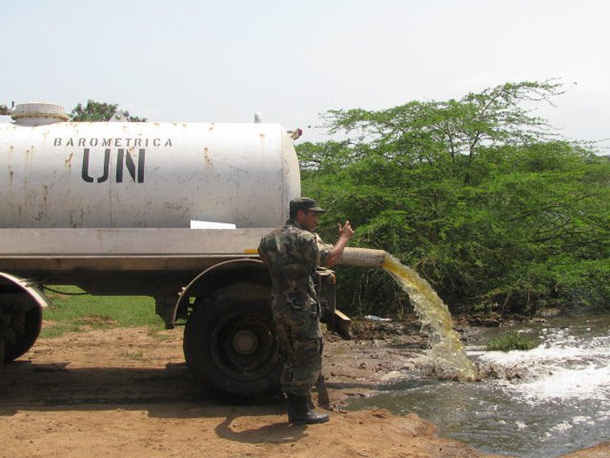- Deadly River: Cholera and Cover-Up in Post-Earthquake Haiti
- ILR Press (2016)
In October 2010, Dr. Renaud Piarroux, a French epidemiologist, was invited by the government of Haiti to investigate the unexpected appearance of cholera in towns and villages along the Artibonite River, the country's largest. Piarroux had extensive cholera experience, notably with a serious outbreak in the Democratic Republic of Congo.
The outbreak had startled everyone: cholera had never been known in Haiti before, and within days of its first known case on Oct. 14, it had infected thousands and killed scores.
Like any good epidemiologist, Piarroux knew that finding the source of an epidemic is critical -- especially in a country as poor as Haiti, which had scarcely recovered from the earthquake of January 2010 that had killed a couple hundred thousand people. (The death toll has been a subject of controversy.)
His search -- and shocking discoveries -- are at the centre of Deadly River: Cholera and Cover-Up in Post-Earthquake Haiti by Ralph R. Frerichs.
Rumours blamed sewage from a camp of Nepali peacekeepers. Jonathan Katz, an American journalist, had documented those suspicions, but they were far from proven. The United Nations peacekeeping force, known as MINUSTAH, had been installed in Haiti after the 2004 ouster of democratically elected president Jean-Bertrand Aristide. But instead of keeping hostile armed forces from attacking one another, the peacekeepers were a kind of heavy-handed police force.
So MINUSTAH was highly unpopular, and might be just a scapegoat. But it was also true that cholera had been a problem in Nepal just before the peacekeeping contingent had left for Haiti.
Three weeks after the start of the outbreak, Piarroux started his investigations in the village of Mèyé, just downstream from the Nepali camp. While he couldn't get into the camp, he learned that a sanitation truck routinely pumped the sewage out of a tank in the compound and transported it to a hilltop pit -- where it routinely overflowed into the stream below when it rained.
Outbreak evidence suggested massive sewage spill
But that wouldn't be enough, Piarroux knew, to trigger a sudden outbreak infecting hundreds within days. The Artibonite is a big river; for enough cholera bacteria to infect so many people so fast, an enormous quantity of contaminated sewage would have been required.
He moved down the river to the sea, finding village after village infected -- except for a few on higher ground that drew their water from other sources.
The timing of the cases meant a massive plume of sewage had moved down the Artibonite past thousands of Haitians who used the river for drinking, irrigation, bathing and washing clothes. For the plume to resist dilution, many symptomatic cases must have discharged their feces into their river in a very short time. If those cases were in the Nepali camp, almost all the soldiers must have been ill -- a possibility loudly denied by the camp commander and the Nepali army back in Kathmandu.
Meanwhile, Piarroux was startled to find UN agencies like the Pan American Health Organization (PAHO) and the Office for the Coordination of Humanitarian Affairs (OCHA) -- and the American Centers for Disease Control and Prevention (CDC) -- uninterested in finding the source of the outbreak. They speculated that it might have come from Vibrio cholerae bacteria in the sea, but said the focus should be on treating the cases. Even then-president René Préval said he wasn't interested in the source.
Piarroux's suspicions were further aroused when the UN peacekeeping force issued a news release saying the first cholera cases had been reported by the Haitian Ministry of Public Health and Population (MSPP) on Sept. 24. The date was three weeks before the first confirmed cases on Oct. 14 -- and MSPP had made no such report.
Piarroux was no stranger to the politics of public health, but this was baffling. The American and UN authorities seemed to be committed to an "environmental" origin for cholera in the Caribbean Sea. Perhaps it had been churned up by the earthquake nine months earlier, or by a hurricane. The theory of importation by the Nepalis, they said, had no evidence to back it up.
Piarroux knew better, but the UN and U.S. agencies even brought in a team of investigators who had built their careers on the theory of environmental cholera. They paid little attention to his findings.
The truth: known in days, concealed for months
But just before leaving Haiti, Piarroux received a secret document: a report by the MSPP, made in the very early days of the outbreak. With remarkable speed, the ministry had sent a team to the Artibonite River and identified the source as the Nepali camp. They'd been denied entry to the camp, but local residents provided plenty of details.
So within days of the outbreak the Haitians had known its source -- and so had CDC and PAHO. Why hadn't they said so, and why had Préval dismissed the idea of finding it?
Piarroux had a pretty good idea. Haitian governments stand or fall at the pleasure of the U.S. government. Washington had probably been behind the ouster of Aristide, and had imposed MINUSTAH rather than send in its own troops -- a politically and financially expensive proposition.
So Haiti was (and is) ruled by a coalition of UN and U.S. agencies plus a chaotic mass of non-governmental organizations. The government in Port-au-Prince was (and is) far from sovereign. Préval had understood his situation, and had sent Piarroux the ministry report anonymously, to help him tell the world what he himself could not.
The U.S.'s big concern in the fall of 2010 was the impending election to replace Préval. Riots and worse would erupt if the UN peacekeepers were named as the source of cholera. Rather than admit their error, the UN and U.S. agencies went straight to obfuscation and misdirection.
A massive international coverup to protect US, UN
And, alarmingly for any serious public health expert, a lot of public health experts went along with the scam. While thousands of Haitians were dying in puddles of their own vomit and diarrhea, the experts did their considerable best to lie to the world about why those people were dying.
Once back in France, Piarroux found it hard to publish his findings, but they eventually made it into print -- in the CDC's journal Emerging Infectious Diseases. He was soon embroiled in debates with his opponents who claimed environmental origins for the epidemic, but his own evidence was simply too strong, and theirs too weak. Eventually, the Nepalis were understood to be the importers of cholera: Piarroux learned that a whole truckload of their sewage had been dumped straight into the river.
Piarroux has revisited Haiti several times, promoting his plan not to "control" cholera but to eliminate it by smothering new outbreaks before they can spread. But the current government prefers to go along with the control program, effectively making cholera endemic.
As of mid-May 2016, cholera has sickened over 780,000 Haitians while killing over 9,000 of them. According to PAHO, between Jan. 1 and April 30 of 2016, 13,859 have fallen ill with cholera and 150 have died -- more than the same periods in 2014 and 2015.
Early in the outbreak, Piarroux was contacted by Dr. Ralph R. Frerichs, professor emeritus of epidemiology at UCLA. Frerichs was also alarmed at the official response to Haiti's cholera. Their online communications grew into face-to-face contact, and eventually into a years-long debriefing in which Piarroux detailed his experiences in Haiti. That in turn led to this book, the best yet written on Haiti's cholera. It is also a medical thriller, a crash course in basic epidemiology and a primer on the politics of global health.
Frerichs writes brilliantly, letting facts and events speak for themselves. The result is a damning indictment of the national and international health agencies -- and the cynical governments that rule them.
The coverup organized by the CDC, the World Health Organization and other UN agencies was a violation of medical ethics on an international scale. They sacrificed Haiti simply to escape political embarrassment.
In fairness, though, none of the great health agencies is a free agent. As science writer Sonia Shah recently noted, "private interests have commandeered the public-health agenda." WHO has been on an ever-dwindling budget for decades. CDC isn't allowed to do research into firearm deaths as a public health issue. Both rely on "donations" from corporate benefactors, not solely on public tax dollars. And the benefactors too often dictate the agenda.
So we get as much public health as our political and corporate masters find convenient. In the case of Haiti, that is very little public health indeed. ![]()
Read more: Health, Rights + Justice

















Tyee Commenting Guidelines
Comments that violate guidelines risk being deleted, and violations may result in a temporary or permanent user ban. Maintain the spirit of good conversation to stay in the discussion.
*Please note The Tyee is not a forum for spreading misinformation about COVID-19, denying its existence or minimizing its risk to public health.
Do:
Do not: